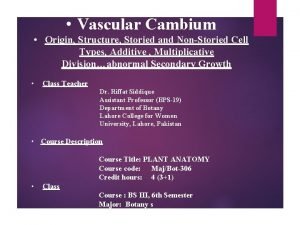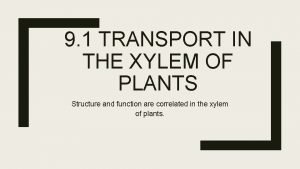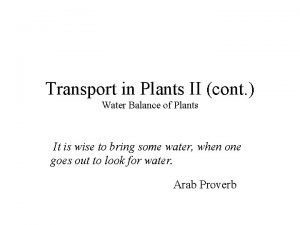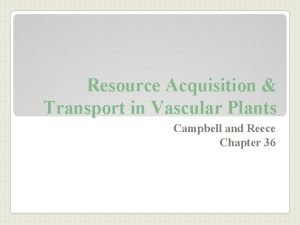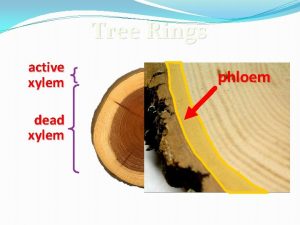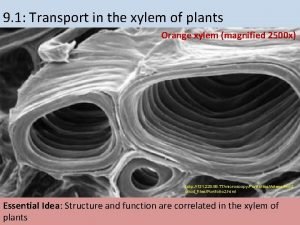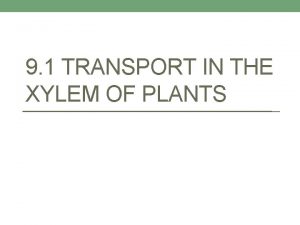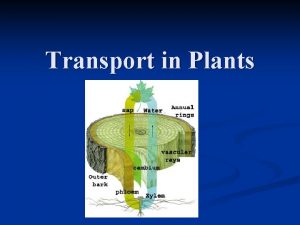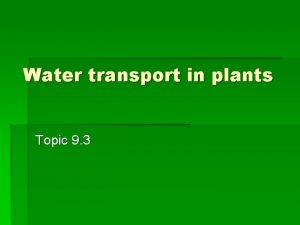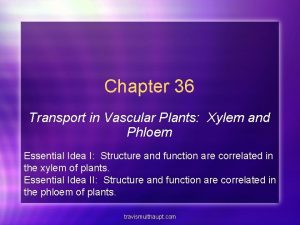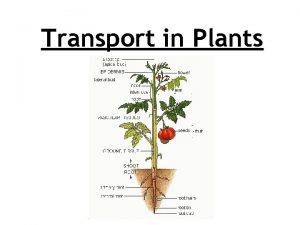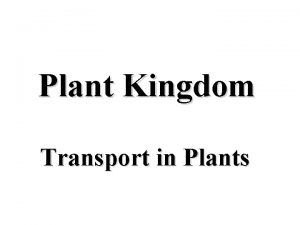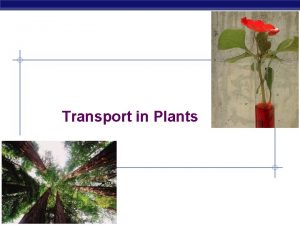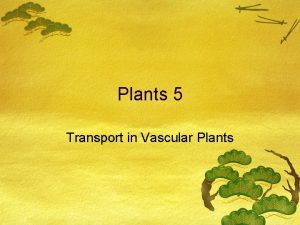9 1 Transport in the xylem of plants















- Slides: 15

9. 1 Transport in the xylem of plants AHL Essential idea: structure and function are correlated in the xylem of plants. One of the key structural features of xylem is the rings of lignin (seen in the lower power scanning EM image). The lignified walls of xylem help them to withstand the very low pressure inside the xylem which drives the transpiration pull. By Chris Paine https: //bioknowledgy. weebly. com/ http: //www. nsf. gov/news/mmg/media/images/Sel-lower 1_70363. jpg

9. 1. U 2 Plants transport water from the roots to the leaves to replace losses from transpiration. AND 9. 1. U 3 The cohesive property of water and the structure of the xylem vessels allow transport under tension.

9. 1. U 2 Plants transport water from the roots to the leaves to replace losses from transpiration. AND 9. 1. U 3 The cohesive property of water and the structure of the xylem vessels allow transport under tension. http: //www. biology. ualberta. ca/facilities/multimedia/uploads/alberta/transport. swf This attraction allows water ‘stick’ to the xylem vessel and hence move upwards.

9. 1. U 4 The adhesive property of water and evaporation generate tension forces in leaf cell walls. In Summary: • The loss of water from the top of xylem vessels due to evaporation lowers the pressure inside the vessel and pulls more water into the vessel due to cohesion • Adhesion attracts water molecules to the walls of xylem and vice versa. • Therefore as the water moving upwards (similarly to cohesion) it pulls inward on the walls of the xylem vessels generating tension - try sucking on a straw when the bottom end is closed. Edited from: http: //www. slideshare. net/gurustip/transport-in-angiospermophytes

9. 1. U 1 Transpiration is the inevitable consequence of gas exchange in the leaf. http: //passel. unl. edu/pages/animation. php? a=transpiration. swf&b=1094 667161

9. 1. U 3 The cohesive property of water and the structure of the xylem vessels allow transport under tension. Xylem cells contain no cytoplasm this provides a larger lumen making water transport more efficient. However because the cells are non-living water transport must be a passive process. Cell walls are thickened to make them stronger Wall are impregnated with lignin*. Lignin may be deposited in different ways, such as spirals or rings. Strengthened xylem walls can withstand very low internal pressures without collapsing. Can you suggest a function of the pits in the cell walls? Xylem cells are arranged end to form continuous vessels. The reduction of the walls between cells in a vessel makes it easier for water to move between cells http: //www. nsf. gov/news/mmg/media/images/Sel-lower 1_70363. jpg *Lignin is a complex fibrous organic polymer which is strong and rigid. It makes plant stems woody.

9. 1. S 1 Drawing the structure of primary xylem vessels in sections of stems based on microscope images. In a cross section (transverse section, TS) of a stem each vascular bundle consists of large xylem vessels toward the inside and smaller phloem cells toward the outside. Xylem vessels can be identified by their large empty lumens and the thickened cell walls. n. b. Some plant stems, such as monocotyledons, do not possess a cambium and so it is not easy to distinguish between the cortex and pith (both are usually labeled together). In these stems the vascular bundles are not arranged in a ring. Edited from: http: //www. slideshare. net/gurustip/transport-in-angiospermophytes

9. 1. S 1 Drawing the structure of primary xylem vessels in sections of stems based on microscope images. Task: draw tissue diagrams of the light micrograph and label the different tissues you can identify. Species unknown http: //plantphys. info/plant_physiology/images/stemvb. jpg

9. 1. S 1 Drawing the structure of primary xylem vessels in sections of stems based on microscope images. Task: draw tissue diagrams of the light micrograph and label the different tissues you can identify. Zea mays (Corn) stem http: //emp. byui. edu/wellerg/Roots%20 and%20 Shoots%20 Lab/Images/Zea%20 Mays%20 Stem%20 P. jpg

9. 1. A 1 Adaptations of plants in deserts and in saline soils for water conservation.

9. 1. U 5 Active uptake of mineral ions in the roots causes absorption of water by osmosis. Water enters the root hair cells by osmosis For osmosis to occur there must be a higher concentration of solutes, e. g. mineral ions inside the cell than in the soil water surrounding the roots. A high concentration of solutes means a there is a low concentration of water in the root hair cells compared to the soil water. Therefore water moves down the concentration gradient and enters the root hair cells. Higher water concentration Lower water concentration Plants take up water and essential minerals via their roots and thus need a large surface area in order to optimise this uptake. The root epidermis may have extensions called root hairs which increase surface area for mineral and water absorption http: //www. bbc. co. uk/staticarchive/441 a 940349 a 662 c 2 e 000 ee 46215 e 29024262 e 92 c. gif http: //rajkumarbiology. weebly. com/uploads/9/6/4/2/9642700/431153986. jpg? 368

9. 1. U 5 Active uptake of mineral ions in the roots causes absorption of water by osmosis. The use of ATP means that cell must respire (aerobically) to carry out active transport. Active uptake of mineral ions results in a higher concentration of minerals in plants than in the surrounding soil

9. 1. U 5 Active uptake of mineral ions in the roots causes absorption of water by osmosis. The use of ATP means that cell must respire (aerobically) to carry out active transport. ow the n k o t d e not ne d l u lant o p h h s c i h w You cess by o r p d e l i ons. i l deta a r e n i uire m cells acq Active uptake of mineral ions results in a higher concentration of minerals in plants than in the surrounding soil

9. 1. A 2 Models of water transport in xylem using simple apparatus including blotting or filter paper, porous pots and capillary tubing. Modelling water transport Water evaporates from the surface of the porous pot Setup each model to see it working. For each model discuss both how it models water transport in plants and what its limitations as a model are; when does it cease to be a good representation? Nature of Science: Use models as representations of the real world- mechanisms involved in water transport in the xylem can be investigated using apparatus and materials that show similarities in structure to plant tissues. (1. 10) Water is lost from the trough as water moves up the tube to replace water lost from the pot 10 m Place a capillary tube in water and the water moves up the tube - the thinner the tube the higher the water rises. Place the end of a strip of filter paper in water and the water will gradually move up the paper. What material is paper made from? For the porous pot to work there must be an airtight seal between the porous pot and the tube. Additionally allow an air bubble to enter the tube to see water movement more clearly.

9. 1. S 2 Measurement of transpiration rates using potometers. (Practical 7) AND 9. 1. S 3 Design of an experiment to test hypotheses about the effect of temperature or humidity on transpiration rates. Potometers vary in design, but all measure transpiration indirectly by looking at the water uptake. As transpiration occurs a bubble of air moves into the tube and towards the plant (to replace the volume of water transpired). Dependent variable: detail how you will measure transpiration in order that you can calculate a rate. Independent variable: will it be temperature or humidity? How will this be varied and what range of values will you use? control variables: What factors could affects the investigation and hence need to be kept constant? Reliability: how many repetitions do you need? Before answering the question consider how you intend to analyse the data. http: //www. findel-international. com/netalogue/zoom/H 24920. jpg
 Gibberellins function
Gibberellins function Xylem passive transport
Xylem passive transport Bioflix membrane transport
Bioflix membrane transport Membrane structures that function in active transport
Membrane structures that function in active transport Primary active transport vs secondary active transport
Primary active transport vs secondary active transport Now answer the questions
Now answer the questions Bioflix activity membrane transport active transport
Bioflix activity membrane transport active transport Passive transport vs active transport venn diagram
Passive transport vs active transport venn diagram Passive trnasport
Passive trnasport Primary vs secondary active transport
Primary vs secondary active transport Unlike passive transport, active transport requires *
Unlike passive transport, active transport requires * Transportation in plants
Transportation in plants Transport in plants
Transport in plants Resource acquisition and transport in vascular plants
Resource acquisition and transport in vascular plants Non vascular plants
Non vascular plants Reproduce by spores
Reproduce by spores
